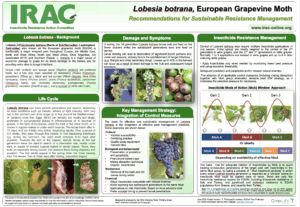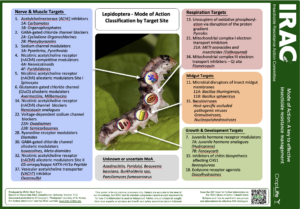European grapevine moth
Lobesia botranaLobesia (=Polychrosis) botrana (Denis et Schiffermuller) (Lepidoptera: Tortricidae)
European grapevine moth (EGVM) is one of the most important pests of grapevines. They can have several generations per season, depending on local conditions such as climate, altitude or light intensity, from only two in the northern part of its range up to four around the Mediterranean, or (seldom) even five. Eggs (40-60 per female) are mostly laid singly, preferably in sun-protected places in inflorescences or in bunches of grapes, in the folds of dry leaves, under the bark or the straw mulch, or in cracks in support-stakes or under earth mounds. The larvae hatch after 4-15 days, and are initially very active, dispersing rapidly. Over a period of 3-4 weeks, they pass through five instars. In non-diapausing individuals (i.e. during the summer), the adult moth emerges 8-14 days after pupation. Towards the end of the season, mature larvae of the last generation leave the plant in search of a hibernation site. There, they build an especially strong cocoon that protects them during diapause and pupation. The first adults appear in the spring when the vines develop their first leaves. Two or three days after mating, oviposition begins.
The economic injury caused by the first generation is generally moderate, as most varieties of grapevine are able to compensate for the loss of flowers to a certain degree. Much more important is the damage to developing or ripe grapes, not least due to the secondary infections that reduce the quality of the wine produced. Table grapes might become unmarketable even if only a few berries are flawed.
Integrated Pest Management
The basis for effective and sustainable management of Lobesia botrana is the integration of cultural, behavioral, biological, mechanical and chemical control tactics.
Cultural methods like varietal susceptibility, appropriate fertilizing practices and high-quality spray equipment are important for good pest management.
Biological methods like preservation of beneficial predators and parasitoids (fam. Braconidae, Chalcididae, Ichneumonidae, Trichogrammatidae etc.), pheromone-baited traps, entomopathogenic nematodes, funguses (Beauveria bassiana, Metarhizium robertsii, Metarhizium anisopliae) and bacteria species (Xenorhabdus spp., Photorhabdus spp.), botanical insecticides (Carlina acaulis oil or Pistacia lentiscus extracts), sterile male insect and mating disruption techniques are also contributing to successful pest management.
Mechanical techniques like piling vineyard soil around the stems during winter to cause mold development on the overwintering pupae or removal of the bark with metal mesh gloves, can kill overwintering pupae. Leaf removal in the bunch zone of the canopy is an efficient way to reduce cluster size and compactness, making them less susceptible to EGVM attack and subsequent rot. Direct sunlight increases berry temperature in a way that EGVM eggs can be killed. Management of the wild flora in or around the vineyard can play an important role in fostering EGVM natural enemies.
When all above measures are not giving a good protection an appropriate insecticide applications are also crucial. Basic rules are to adopt insecticides compatible with natural enemies, avoid exposing two subsequent generations to the same MoA. Chemical applications should be based on economic thresholds and predictive models to prevent larval penetrations in the berries (ovi-larvicidal treatment).
European grapevine moth resistance profile
Control of Lobesia botrana may require multiple insecticide applications in one season even if appropriate IPM is applied. Foliar insecticide sprays are mostly targeted to the control of the 2nd generation in wine grapes and to the 2nd and 3rd in table grapes. Normally 1 to 3 applications are needed in wine grapes and up to 6 in late-maturing table grapes. Although farmer complains on EGVM control is not rare, there are only a few insecticide resistance reports/publications available for L. botrana, including indoxacarb, pyrethroids and spinosad resistance in a few EU countries as shown below.
| Species | Distribution | Chemical class | Mechanisms |
|---|---|---|---|
| Lobesia botrana | EU- Italy, Turkey | Indoxacarb (22A) | Seems not target site |
| Lobesia botrana | EU- Greece, Turkey | Pyrethroids-Pyrethrins (3A) | Seems not target site |
| Lobesia botrana | EU- Greece, Turkey | Spinosyns (5) | Seems not target site |

